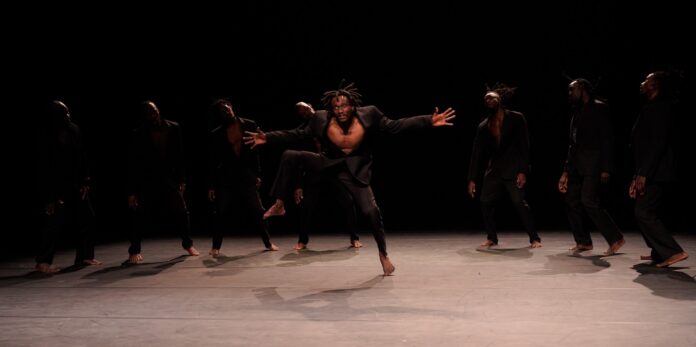Josef Nadj is a performer, choreographer, visual artist, photographer born in a Hungarian-speaking enclave in Serbia, Europe. OMMA is his latest creation as a result of a turning point meeting with eight african dancers.
From Central Europe to Africa
Africa represents for Europe the testing ground of “maximum diversity”.
For this reason, Josef Nadj focused on Africa for his latest OMMA creation, from Greek root of eye, to look, to see. He is a performer, choreographer, visual artist, and photographer, born in 1957 in a Hungarian-speaking enclave of Serbia, who has lived and worked in France for decades.
Moreover, he has explored the world of Kafka, Bruno Schulz, Woyzeck, lots of the literature of Central Europe, admiring Artaud and Balthus. After having built his fascinating huis clos on stage and with every other expressive instrument, the meeting with eight dancers from Mali, Senegal, Ivory Coast, Burkina Faso, French Congo and Congo Zaire, opened the doors to him towards an existential and artistic turning point.
OMMA virtuosity
OMMA, invited to the Biennale of Lyon and the Venice Biennale, co-production of many French “dance houses” with Charleroi Danse, in Belgium, goes to the roots of dance, to its natural, organic raison d’etre, to the expression of the spirit of a community in harmonic connection starting from sharing steps and rhythms, possibly improvising together. The ritual is in the dance itself, pure. There is no need for any reference to myths and legends, holidays, or celebrations. Only at the end there is an allusion to the red thread of life that passes from the dead to the newborn in a seamless cycle.
If white dance has its highly codified moments of prowess, black dance is equally virtuosic by other means, from traditional elements to contemporary urban ones.
France and Africa
Meanwhile, Macron’s France had launched a very ambitious project, Africa2020, which could only take place this year. It touches many cities, Paris, Nantes, Marseille, Roubaix, Sant-Denis, Rennes, Metz, Montpellier, as well as relying on bases in Senegal, Burkina Faso, Central African Republic, Congo, Cameroon. Through this large platform many exhibitions and events take place, which are curated by N’Goné Fall, a scholar born in Dakar. The goal is to enhance the many faces of creativity of the Black Continent, or rather of “Africa”, renewing the approach in the complex relationship with the former colonies.
The bill is wide: live performance, contemporary art, fashion / design, music, virtual reality, food, cinema.
https://www.saisonafrica2020.com/en
You can also read:
African dance and its filiation – Arte africana e afro-discendente
Josef Nadj è un performer, coreografo, artista visuale, fotografo nato in un’enclave Serba dove si parla ungherese. OMMA è la sua ultima creazione, per la cui realizzazione è stato determinante l’incontro con otto ballerini africani.
Dalla Mitteleuropa all’Africa
L’Africa rappresenta per l’Europa il banco di prova della “massima diversità”.
Per questa ragione Josef Nadj, performer, coreografo, artista visivo e fotografo, nato nel 1957 in una enclave della Serbia dove si parla ungherese, che da decenni vive e lavora in Francia, ha puntato sull’Africa per la sua ultima creazione OMMA, dalla radice greca di occhio, guardare, vedere.
Dopo aver esplorato per decenni il mondo di Kafka, di Bruno Schulz, del Woyzeck, di tanta letteratura della Mitteleuropa, ammirando Artaud e Balthus, e dopo aver costruito i suoi fascinosi huis clos d’autore in scena e con ogni altro strumento espressivo, l’incontro con otto danzatori provenienti da Mali, Senegal, Costa d’Avorio, Burkina Faso, Congo francese e Congo Zaire, gli ha aperto le porte verso una svolta esistenziale e artistica.
OMMA e il virtuosismo
OMMA, invitato alla Biennale de Lyon e alla Biennale di Venezia, coproduzione di molte “case della danza” francesi con Charleroi Danse, in Belgio, va alle radici della danza, alla sua ragion d’essere naturale, organica, all’espressione dello spirito di una collettività in sintonia armonica a partire dal condividere passi e ritmi, eventualmente improvvisando insieme; la ritualità è nella danza in sé, pura. Non è necessario alcun riferimento a miti e leggende, feste o celebrazioni. Solo al termine si allude al filo rosso della vita che passa dai defunti ai nuovi nati in un ciclo senza soluzione di continuità.
Se la danza bianca ha i suoi momenti altamente codificati di bravura, la danza nera è altrettanto virtuosistica con altri mezzi, dagli elementi di tradizione a quelli urbani attuali.
Francia e Africa
La Francia di Macron intanto aveva lanciato un progetto molto ambizioso, Africa2020, che ha potuto svolgersi solo quest’anno toccando molte città, Paris, Nantes, Marseille, Roubaix, Sant-Denis, Rennes, Metz, Montpellier, oltre a contare su basi in Senegal, Burkina Faso, Repubblica Centro Africana, Congo, Camerun; una grande piattaforma con mostre ed eventi a cura di N’Goné Fall, studiosa nata a Dakar, per valorizzare i tanti volti della creatività del Continente Nero, o meglio delle “Afriche”, rinnovando l’approccio nella complessa relazione con le ex colonie.
Il cartellone è ampio: live performance, contemporary art, fashion/design, musica, virtual reality, cibo, cinema.
https://www.saisonafrica2020.com/en
Leggi anche:








